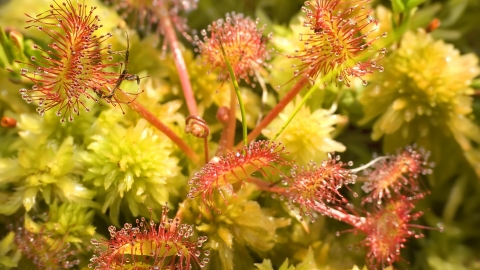
Roundleaved Sundew - Leszek Wygachiewicz
Brimley Hill Mire
Know before you go
Dogs
Visit the 'Dog walking on reserves' page in the Contact section for more information.
When to visit
Opening times
Open at all timesBest time to visit
April to AugustAbout the reserve
This reserve has some wonderful examples of spring fed mire, also known as bog, plant communities. Ground water running through the Greensand geology below emerges in the reserve and then flows across the surface before running down to join the River Culm.
For such a small site it has tremendous variety of wet ground plants including Bog Pondweed, Bog Pimpernel, Bog Asphodel, Pale Butterwort, Oblong-Leaved and Round-Leaved Sundew. Several species of Sphagnum mosses, known as Bog Mosses, occur where the ground is at its wettest.
This tiny reserve really is a wonderful mosaic of habitats. It even has a fringe of mainly Birch and Rowan woodland around the drier edges of the reserve which is very good for ferns. These include Lady Fern, Hard Fern, Scaly Male Fern, Broad Buckler Fern, Hart's Tongue and Bracken. There is even an old record of Royal Fern. The following mammals have been recorded, Badger, Roe deer and Harvest Mouse. There is a badger set on the bank behind the mire. The dragonflies found here include Keeled Skimmer, Golden-Ringed Dragonfly, Southern Hawker and Blue-Tailed Damselfly. Forty one species of spiders and six species of harvestman have been recorded.
In high summer the white fluffy heads of Common Cottongrass are very distinctive across the mire. Devil's-bit Scabious, Lesser Skullcap and Marsh Violet can also be found on the damper ground. On higher and drier parts of the reserve there is a heath type flora with Purple Moor-Grass, Tufted Hair-Grass, Cross-Leaved Heath, Common Heather, Lousewort and Heath Milkwort.
This is a great place to visit in summer when the flowers are out and the many small pools can have large numbers of dragonflies and damselflies skimming about them.
Reserve conservation management - Periodic grazing with ponies. Rotational scrub clearance to control gorse and scrub and to stop woodland from spreading across the reserve from the woodland edges.



